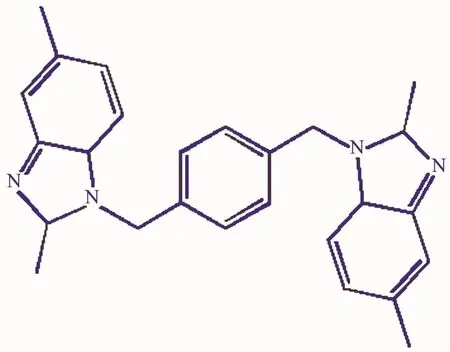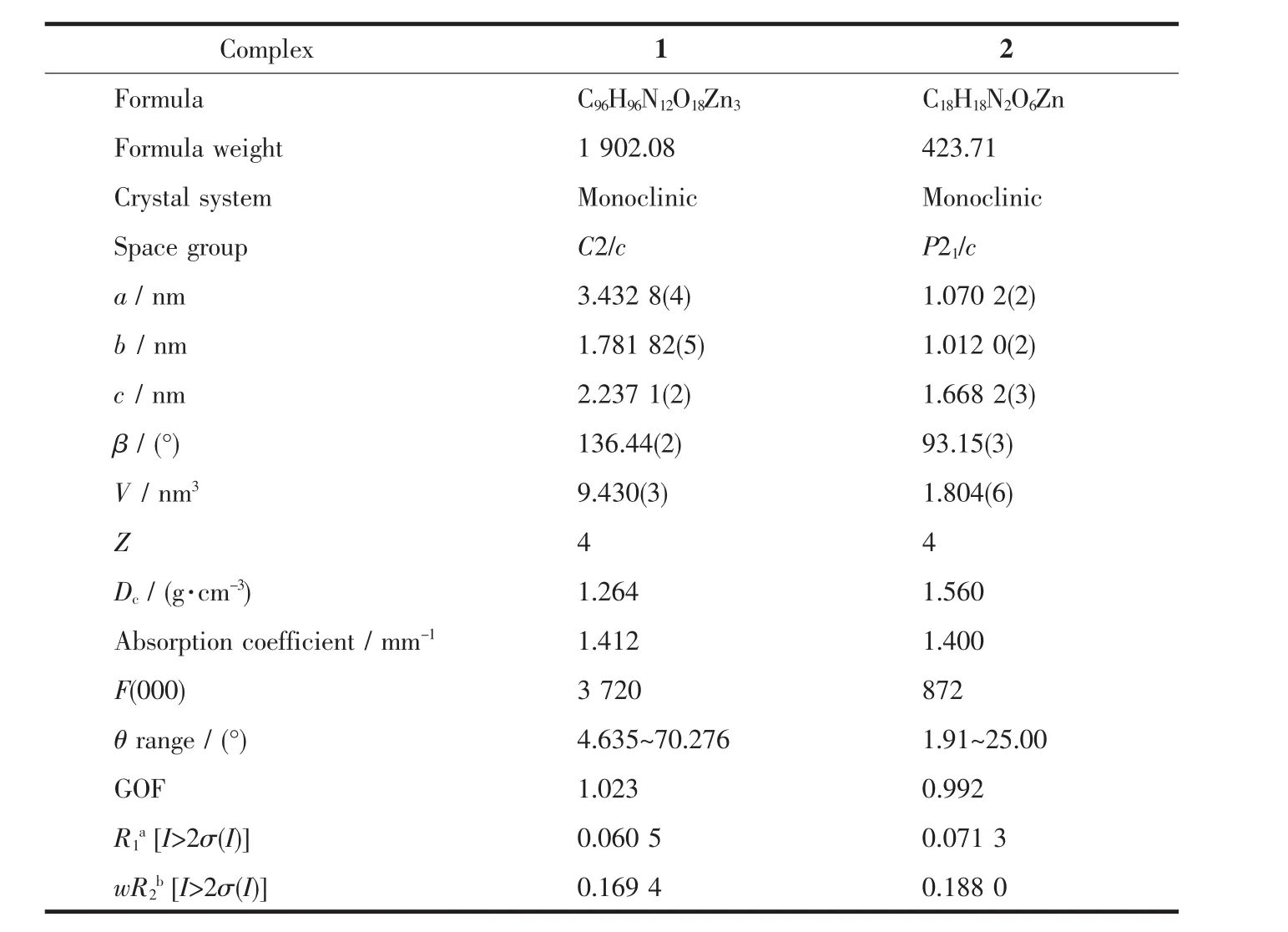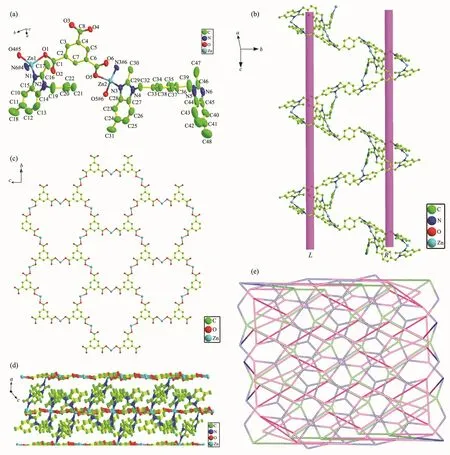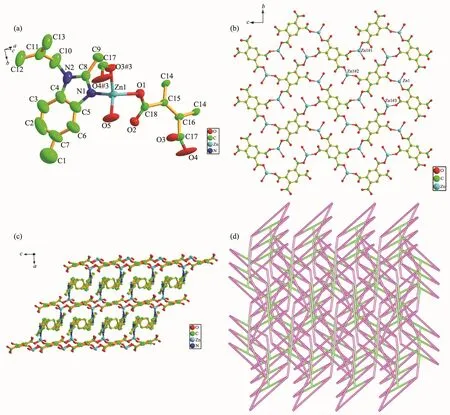两个三维锌Ⅱ配位聚合物的晶体结构及荧光性质
2019-03-13王键吉张裕平侯红卫
刘 露 李 英 王键吉 张裕平 侯红卫
(1河南师范大学化学化工学院博士后研发基地,新乡 453007)
(2河南科技学院化学化工学院博士后研发基地,新乡 453003)
(3郑州大学化学与分子工程学院,郑州 450052)
To date,the design and construction of coordination complexes have been quickly developing because of their intriguing structural motifs and potential applications[1-9].The researches in this field have been concentrated on the structural tuning of the resulting complexes via selecting proper metal centers and different organic ligands[10-12].As far as we can see,1-(4-((2,6-dimethyl-2H-benzo[d]imidazol-3(3H)-yl)methyl)benzyl)-2,7-dihydro-2,5-dimethyl-1H-benzo[d]imidazole(dbim)(Scheme 1)has been rarely mentioned as the semi-rigid N-donor ligand in metal-organic coordination polymer materials.Not only two dimethylbenzimidazole of dbim can freely twist around two-CH2-groupswith disparate anglesto produce unlike conformations,but also the existence of the methyl in the imidazole ring and benzene ring can boost the donated electrons ability of dbim,which is conducive to enrich coordination ability of dbim with metal ions.

Scheme 1 Structure of ligand dbim
The polycarboxylate ligands,as a star in the coordination chemistry,are also of especial interest and have been widely used to fabricate various coordination complexes,owing to their strong coordination ability and diverse coordination modes[13-17].In addition,the two-ligand assembly system is capable of providing more variability to build complicated and fascinating structures.Therefore,multidentate O-donor carboxylate ligands,trimesic acid(H3btc)and 1,2,4,5-benzene tetracarboxylic(H4btec)are introduced,and two diverse 3D complexes,{[Zn1.5(dbim)1.5(btc)]·6H2O}n(1)and{[Zn(dbim)0.5(btec)0.5(H2O)]·H2O}n(2)were synthesized.The crystal structure analysis of the complexes,and the effect of different multi-carboxylates on the final frameworks,are also discussed. The structural differences demonstrate that the backbones of the multi-carboxylates are key factors in formation of the final coordination complexes.Moreover,the photoluminescence of the complexes 1 and 2 were also reported.
1 Experimental
1.1 Materials and method
All reagents and solvents were commercially available except for dbim,which was synthesized according to the literature[18].FT-IR spectra were recorded on a FTIR-7600 spectrophotometer with KBr pellets in 400~4 000 cm-1region.Elemental analyses(C,H and N)were carried out on a FLASH EA 1112 elemental analyzer.The luminescence spectra for the powdered solid samplesweremeasuredatroom temperature on a F7000 fluorescence spectrophotometer.The excitation slit and emission slit were both 2.0 nm.
1.2 Synthesis of{[Zn1.5(dbim)1.5(btc)]·6H2O}n(1)
A mixture of Zn(Ac)2·2H2O(0.2 mmol),dbim(0.1 mmol),H3btc(0.2 mmol)and NaOH (0.2 mmol)in H2O (10 mL)was kept in a 25 mL Teflon-lined stainless steel vessel at 140℃for four days.After the mixture was cooled to room temperature at a rate of 5℃·h-1,colorless crystals suitable for X-ray diffraction were obtained with a yield of 55%(based on Zn).Anal.Calcd.for C96H96N12O18Zn3(%):C,60.61;H,5.08;N,8.83.Found(%):C,60.57;H,5.09;N,8.81.IR(KBr,cm-1):3 418(w),2 862(vw),2 359(w),1 698(w),1 615(s),1 567(s),1 516(s),1 493(s),1 415(w),1 330(s),1 286(w),1 259(w),1 172(w),1 100(w),1 035(w),994(w),936(w),867(w),803(s),726(s),670(w).
1.3 Synthesis of{[Zn(dbim)0.5(btec)0.5(H2O)]·H2O}n (2)
A mixture of Zn(Ac)2·2H2O(0.2 mmol),dbim(0.1 mmol),H4btec(0.1 mmol),NaOH(0.2 mmol)and H2O (10 mL)was placed in a 25 mL Teflon-lined stainless steel container.The mixture was sealed and heated at 160℃for three days.After the mixture was cooled to ambient temperature at a rate of 5℃·h-1,colorless crystals of 2 were obtained with a yield of 49%(based on Zn).Anal.Calcd.for C18H18N2O6Zn(%):C,51.01;H,4.28;N,6.61.Found(%):C,50.98;H,4.27;N,6.63.IR (KBr,cm-1):3 424(m),3 378(m),2 923(w),1 612(vs),1 511(w),1 488(s),1 405(s),1 355(vs),1 135(s),1 037(w),868(m),815(s),759(m),682(m),607(m),508(w).
1.4 Crystal structural determination
The data of 1 and 2 were collected on a Xcalibur Eos Gemini CCD diffractomer (Cu Kα for 1,λ=0.154 18 nm;Mo Kα for 2,λ=0.071 073 nm)at temperature of(20±1)℃.Absorption corrections were applied by using multi-scan program.The data were modified for Lorentz and polarization effects.The structure of complex 1 was solved and refined by fullmatrix least squares on F2using OLEX2[19],while the structure of complex 2 was solved by direct methods and then refined by means of F2with a full-matrix least-squares technique that adopted the SHELX-97 crystallographic software package[20].The hydrogen atoms were placed at calculated positions and refined as riding atoms with isotropic displacement parameters.Crystallographic crystal data and structure processing parameters for 1 and 2 are summarized in Table 1.Selected bond lengths and bond angles of 1 and 2 are listed in Table 2.
CCDC:1584788,1;1584789,2.

Table 1 Crystal data and structure refinement details for complexes 1 and 2

Continued Table 2
2 Results and discussion
2.1 Crystal structure of{[Zn1.5(dbim)1.5(btc)]·6H2O}n(1)
As illustrated in Fig.1a,the asymmetric unit of complex 1 consists of two crystallographically independent ZnⅡion,one and a half dbim ligands,one btc3-ligand and six lattice water molecules.Zn1Ⅱion is four-coordinated by two carboxylate oxygen atoms(O1 and O4#5)from two btc3-anions,two nitrogen atoms(N1 and N6#4)from two dbim ligands.The Zn1-O1/O4#5 bond distances are 0.200 9(2)/0.199 1(2)nm,while the Zn1-N1/N6#4 bond lengths are 0.202 4(4)/0.201 1(4)nm,respectively.Zn2 atom is also fourcoordinated geometry,which is completed by two oxygen atoms(O5 and O5#6)originating from two different btc3-anions and two nitrogen atoms(N3 and N3#6)from two dbim ligands.Both of the distances of Zn2-O5/O5#6 are 0.199 4(2)nm,while the Zn2-N3/N3#6 bond lengths are 0.204 2(3)/0.204 1(3)nm.

Fig.1 (a)Coordination environment of ZnⅡion in 1 with hydrogen atoms omitted for clarity;(b)1D meso-helix chain built though ZnⅡ ions and dbim linkers in 1;(c)2D layer structure of 1 constructed by ZnⅡ ions and btc3-linkers;(d)Schematic view of 3D framework built by 1D ZnⅡ/dbim and 2D ZnⅡ/btc3-layers in 1;(e)Schematic description of a(3,4,4)-connected 3D network with(52·6·7·82)(52·6)(52·62·82)topology for 1
There are two independent dbim ligands in complex 1.dbim-Ⅰexhibit asymmetrical cis-conforma-
2.2 CrystalStructureof{[Zn(dbim)0.5(btec)0.5(H2O)]·H2O}n(2)

Fig.2 (a)Coordination environment of ZnⅡion in 2 with hydrogen atoms omitted for clarity;(b)2D sheet generated by ZnⅡ ions and btec4-linkers in 2;(c)Schematic view of 3D framework built by 2D ZnⅡ/btec4-layers and dbim pillars in 2 with H atoms omitted for clarity;(d)Schematic view of the 3D topology network with the point symbol of(83)(85·10)for 2
As illustrated in Fig.2a,the asymmetric unit of complex 2 consists of one ZnⅡion,half a dbim ligand,half a btec4-ligand,one coordinated water molecule and one lattice water molecule.Each ZnⅡion is four-coordinated by two carboxylate oxygen atoms(O1 and O3#3)from two btec4-anions,one nitrogen atom (N1)from one dbim ligand and one oxygen atom(O5)from one water molecule.The Zn-O bond distances vary from 0.193 1(3)to 0.195 1(3)nm,while the Zn-N1 bond length is 0.200 0(4)nm.Ligand dbim adopts symmetric trans-conformation with antorsion angle of 74.697°.The btec4-anion presents a quadridentate coordination mode,with four carboxylate groups showing a monodentate mode.The ZnⅡions are connected by btec4-anions to form a 2D sheet structure (Fig.2b),which is connected by dbim ligand in a tran-conformation via the Zn-N connection to generate a 3D pillar-layered framework(Fig.2c).To further demonstrate the overall 3D structure of 2,we can consider each ZnⅡas a 3-connecting node,which is linked to three equivalent nodes through one dbim ligand and two btec4-ligands.Moreover,the btec4-ligand can be simplified as a 4-connecting node and dbim is defined as a linker,the 3D framework of 2 can be described as(83)(85·10)topology(Fig.2d).
2.3 Effect of dbim and carboxylate co-ligands on structures of 1 and 2
As described above,the semi-rigid dbim ligand presents two independent conformation (dbim-Ⅰand dbim-Ⅱ,respectively)in 1.dbim-Ⅰ exhibit asymmetrical cis-conformation,while dbim-Ⅱexhibit symmetrical trans-conformation.The two types of dbim bridges adjacent ZnⅡions alternately to give rise to a meso-helix chain.However,in 2,dbim adopts single symmetric trans-conformation and serves as bridging pillar linking adjacent 2D ZnⅡ/btec4-layer,which makes 2 show 3D pillar-layered framework.The semirigid dbim can rotate freely when coordinating with central metal ions because of the flexible nature of the-(CH2)-spacers,which can greatly beautify and enrich the structure of complexes.
The carboxylate anions have important influence on the constructing of resultant 3D structures.In this work,we selected two multi-carboxylic acids (btc3-and btec4-)as co-ligands.By introducing ligand btc3-,3D(3,4,4)-connected(52·6·7·82)(52·6)(52·62·82)topology net 1 are obtained.When btec4-is introduced into the synthetic procedure of 2,3D(3,4)-connected(83)(85·10)topology are built.These results show diverse carboxylate co-ligands exert a pivotal influence on the features and overallstructures ofthe resultant complexes.
2.4 Photoluminescence properties

Fig.3 Photoluminescent spectra of ligand dbim(a)and complexes 1~2(b)in solid state at room temperature
Fluorescence properties of the coordination complexes with d10metal centers have attracted more interest owning to their potential applications[21-23].Hence,the solid-state photoluminescent spectra of free dbim ligand and ZnⅡ complexes 1~2 were investigated at ambient temperature,as depicted in Fig.3.The free ligand dbim displayed an emission band at 314 nm(λex=252 nm).As reported before[24],the photoluminescent spectra of H3btc and H4btec showed different emission peak at 395 nm(λex=355 nm)and 340 nm (λex=310 nm),respectively.For complex 1,excited at 317 nm,it gave rise to an emission band at 380 nm (Fig.3).As compared to dbim ligand,a red shift (66 nm)was observed.As compared to H3btc ligand,a smaller hypsochromic shift (15 nm)was observed.Theemission spectrum ofcomplex 2 displayed an emission band centered at 446 nm with excitation maximum at 355 nm and the emission band presented larger red shifts(106 and 132 nm)compared with those of ligand H4btec and dbim,respectively.According to the reference[24],the emission spectra of 1 and 2 are similar to those of H3btc and H4btec ligand,respectively,which also be mainly ascribed to the intraligand emission of H3btc and H4btec ligand,respectively[24-28].
3 Conclusions
In conclusion,by the introduction of two different multi-carboxylic acid co-ligands,two varied 3D architectures can be constructed from ZnⅡsalts and the semi-rigid bis(dimethylbenzimidazole)ligand.The successful fabrication of complexes 1 and 2 may furnish meritorious insights into the construction of wonderful frameworks.Moreover,1 and 2 exhibit fluorescence properties,and maybe display potential for optical materials.
